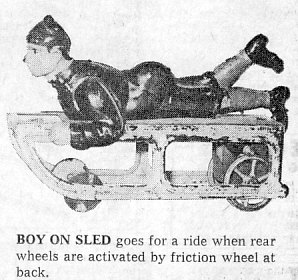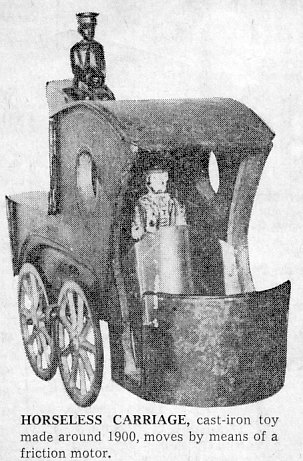|
1968
— PHILADELPHIA BULLETIN
His Hobby Is a Houseful of Antique Toys
Leon J. Perelman Restores Society Hill Mansion As a Museum for His
Collection

By Blanche
Krause
Of The Bulletin Staff
THE TIN sled — with the boy in the red stocking cap going "belly
whopper" — moves via friction action.
So does the "horseless carriage" driven by a tiny woman doll, with
a footman riding high on a back seat.
They're some of the toys children played with from about 1820
through the early years of this century.
They will be on display in a special "shoppe" on Head House Square,
2d and Pine sts., as one of the period attractions of Society Hill Week,
which runs next Saturday through June 11.

INTRICATELY fashioned of colorfully painted tin or cast iron, the
antique toys are the property of Leon J. Perelman, president of American
Paper Products Co., with headquarters here and eight branches throughout
the country.
Perelman is currently restoring the historic Abercrombie House at
268 S. 2d st. to be a permanent museum for his collection of thousands
of old toys.
"I want to give the public an opportunity to see this interesting
part of our heritage, and I think the Society Hill area is more
conducive to exposure than this" — this being the $10,000 addition he
built on his Merion home in 1962 to house the ever-growing collection.
Toys made of tin preceded the cast iron ones, he explained, and the
iron ones continued to be made until shortly before World War I.

MECHANICAL banks are
his specialty. Between 1867 and 1902, 243 different types are known to
have been manufactured, and collectors all over the United States
compete for them. Perelman's collection, with 225 different kinds, is
one of the largest.
"The banks originally sold for about a dollar, quite an investment
for a parent in those days. Today collectors pay as much as $2,500 for
some of them," Perelman says.
The banks were designed to encourage children to save by providing
a variety of action on deposit of a penny. Though they are mostly
chipped and scratched from their long years of amusing children, all the
Perelman banks are in prime working condition. The museum has a special
attendant to see to that.
He placed a penny on the breech of a hunter's rifle, pushed a lever
and the coin dropped into a hole in a tree trunk. A bear's head popped
out of the top of the trunk, and the hunter flipped up his head in
surprise.
A penny dropped in the roof of a fire house caused bells to ring,
doors to fly open and a pumper drawn by four horses to dash out.
There are banks where a penny deposit causes a little girl to jump
rope; a performing dog to jump through a hoop; a cow to knock a farmer
off his milking stool and dump the pail of milk over his face; a Jonah
figure to toss the penny into a whale's mouth; and an American flag to
wave over the North Pole.

WHEN the Abercrombie
House museum opens, probably late this fall, guides will be available
and regular performances by the mechanical banks will be scheduled.
Perelman has been interested in old toys since boyhood when he used
to accompany his mother on trips to antique shops. While she sought
ceramics, he studied cast iron toys.
But the mechanical bank specialty began eight years ago. "There was
a hobby show at our Iowa plant, and one fellow had a display of the
banks," he recalls. "I bought some of his duplicates, and went on from
there."
|




